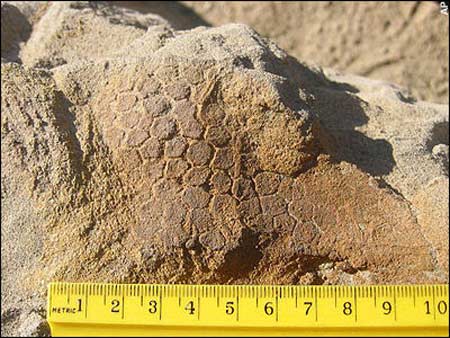A partially mummied dinosaur was found in North Dakoda with its intact skin tissues, media reports said Tuesday quoting paleontology researchers.
The skin of a dinosaur -- a hadrosaur that lived some 65 million years ago -- pokes out of the soil at Hell Creek Formation, North Dakota, in this undated handout released Dec. 3, 2007. A partially mummified hadrosaur discovered by a teenager in North Dakota, may be the most complete dinosaur ever found, with intact skin that shows evidence of stripes and perhaps soft tissue, researchers said on Monday.
The fossilized dinosaur, dubbed Dakota, may reveal secrets locked away for millions of years, allowing scientists to calculate its muscle volume and reconstruct its musculature in ways previously difficult to do.
"This is not a skin impression. This is fossilized skin," paleontologist Phil Manning of the University of Manchester said in a telephone interview. "When you run your hands over this dinosaur's skin, this is the closest you are going to get to touching a real dinosaur, ever."
The fossilized skin with clear remains of scales provide evidences that the animal had stripes, Manning said.
The specimen weighs close to 10,000 pounds (4,536 kilograms). Researchers said scan is needed to make sure if the head is in there, which may take several months to complete.
Researchers described the creature as a hadrosaur, a plant-eating dinosaur that lived 67 million years ago, walked on two legs, and ran at speeds of up to 28 miles (45 kilometers) an hour.
(Xinhua News Agency via agencies December 4, 2007)


